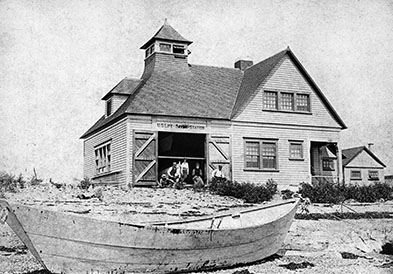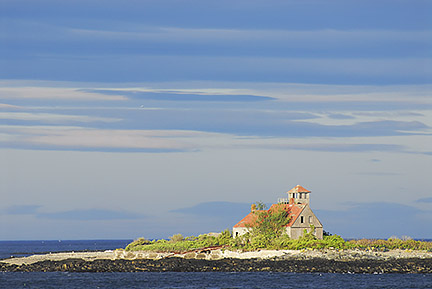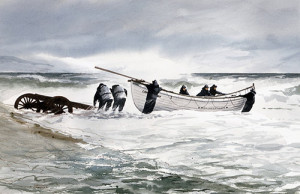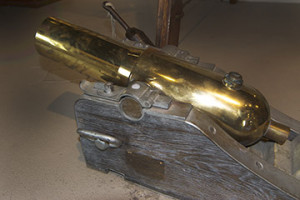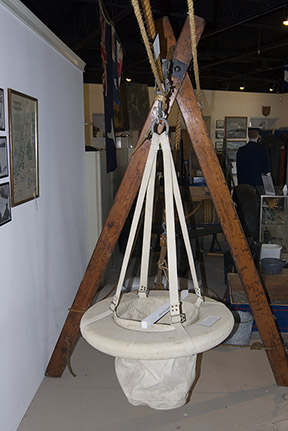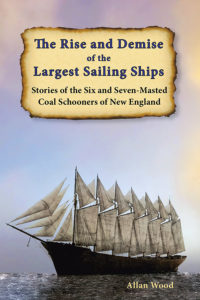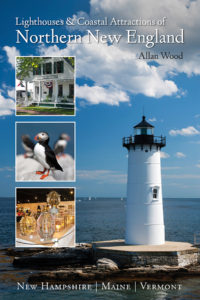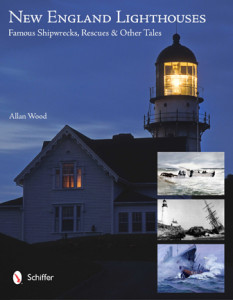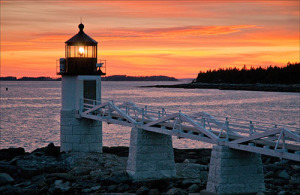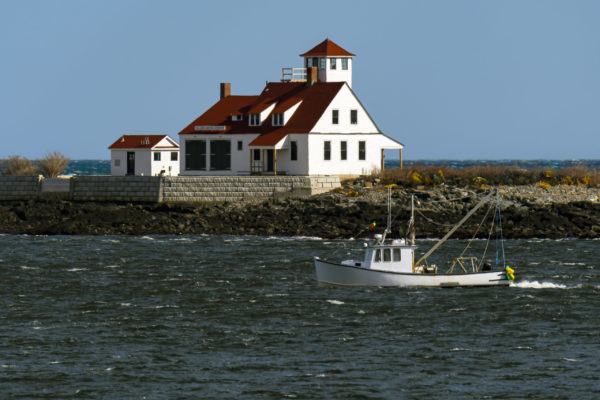
Wood Island Lifesaving Station, also called Jerry’s Point Lifesaving Station, is under restoration on Wood Island in southern Maine.
Lighthouse History: Lifesaving Stations Around Lighthouses
Lifesaving Stations Were Built to Assist in Rescues with Their Trained Surfmen
Shipping, tourism, fishing, and whaling traffic dramatically increased after the Civil War, and there came the need for lifesaving stations to be built along the shores within a few miles of lighthouses. They could provide a broader area range in rescuing stranded survivors from the many shipwrecks throughout New England. This idea of having shore-based stations began with trained volunteer services set up by the Massachusetts Humane Society and spread to each state’s Humane Society.
Congress established the US Life Saving Service in 1871, consisting of a keeper, captain, and a trained crew of 6-8 men, with the necessary buildings to house these crews and their equipment. In the 1870s, nine stations were built on Cape Cod: Race Point, Highlands, Peaked Hill Bars, Pamet, Cahoon’s Hollow, Nauset, Orleans, Chatham, and Monomoy Point.
Where the lighthouse keepers and their assistants were only allowed to attempt rescues within the lighthouse’s proximity, these newly established lifesaving stations covered a much more vast area. They could assist a greater number of distressed survivors on a wreck a distance from the shore. They were more mobile, and their personnel were explicitly trained to rescue survivors.
Their crew consisted of experienced local mariners and fishermen, mostly volunteers, to assist in training and rescue efforts when the New England weather was the most dangerous from Autumn through Spring. These men were called “surfmen” as they got their name from launching heavy lifeboats into the thunderous surf. Their daily routines consisted of drills in using lifesaving equipment on the beach or rocks and shooting a small cannon called a lyle gun at a practice pole as if it were a ship’s mast. They would go on daily shore patrols over five miles from either side of the station to watch for stranded wrecks.
Surfmen used an extremely heavy lifeboat pulled on a cart, either by horse or by the men themselves, to a site near the wreck where it could be safely launched into the surf along the shore in any weather. If a ship wrecked too close to shore to use the lifeboats safely, the surfmen would use a nearly 200-pound small cannon-like gun called a lyle gun, which, when fired, would send a line out to the wreck up to 800 yards. The stranded sailors would secure the line to the wreck, and then the surfmen would securely fasten the other end to a sturdy high post, boat, or rock along the shore. The survivors would then hold onto the line to try to guide themselves to shore with the help of their rescuers.
In a perilous rescue attempt, if a lyle gun could not be used, the surfmen would have to resolve to wade into the dangerous surf and use a heaving stick to get a line aboard the ship. One of their other pieces of equipment was a breeches buoy, which looked like a life preserver with canvas pants attached to catch the survivor so he or she could be towed ashore.
The unofficial motto of the surfmen was that “you had to go out, but you did not have to come back.” Many surfmen risked their lives to save shipwrecked victims, and some received Lifesaving Medals from the Government for performing their duties under extreme conditions or from the Humane Society itself. They were the most trained and experienced boaters and performed their duties at significant risk to their own lives. Lifesaving stations were part of the US Lighthouse Service.
Regards,
Allan Wood
Books to Explore
The Rise and Demise of the Largest Sailing Ships: Stories of the Six and Seven-Masted Coal Schooners of New England. In the early 1900s, New England shipbuilders constructed the world’s largest sailing ships amid social and political reforms. These giants were the ten original six-masted coal schooners and one colossal seven-masted vessel, built to carry massive quantities of coal and building supplies and measured longer than a football field! This self-published book, balanced with plenty of color and vintage images, showcases the historical accounts that followed these mighty ships.
Available also from bookstores in paperback, hardcover, and as an eBook for all devices.
Enjoy a 10% discount on the hardcover version. Printed and distributed by IngramSpark.

Book – Lighthouses and Coastal Attractions in Southern New England: Connecticut, Rhode Island, Massachusetts
Lighthouses and Coastal Attractions of Southern New England: Connecticut, Rhode Island, and Massachusetts. This 300-page book provides memorable human interest stories from each of the 92 lighthouses and information about the lifesaving service. You can explore plenty of indoor and outdoor coastal attractions, including whale-watching excursions, lighthouse tours, windjammer sailing tours, parks, museums, and even lighthouses where you can stay overnight. You’ll also find plenty of stories of hauntings around lighthouses.
Lighthouses and Coastal Attractions of Northern New England: New Hampshire, Maine, and Vermont. This 300-page book provides memorable human interest stories from each of the 76 lighthouses and information about the lifesaving stations. It also describes and provides contact info for plenty of indoor and outdoor coastal attractions and tours. These include whale watching, lighthouse tours, unique parks, museums, and lighthouses where you can stay overnight. There are also stories of haunted lighthouses in these regions.
New England Lighthouses: Famous Shipwrecks, Rescues & Other Tales contains over 50 stories and information regarding lifesaving stations. This image-rich book also contains vintage images provided by the Coast Guard and various organizations and paintings by six famous Coast Guard artists.
You can purchase this book and the lighthouse tourism books from the publisher Schiffer Books or in many fine bookstores such as Barnes and Noble.
Copyright © Allan Wood Photography, do not reproduce without permission. All rights reserved.
Join, Learn, and Support The American Lighthouse Foundation
